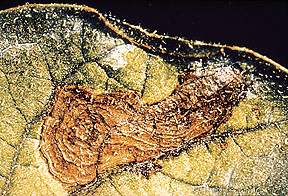Early Blight in Potatoes
Unlike the name suggests, the disease often first appears in late July. The disease commonly occurs in most potato growing areas. Under severe infections, leaves are often killed, reducing yields, and tuber infections make the diseased potatoes unmarketable. It is most severe on maturing foliage and plants or under-fertilized potato vines.

Host Crops
Potato and Tomato
Biology
Mycelium and spores overwinter in soil or on crop residue (dead leaves and vines, infected tubers). Spores may be carried to leaf surfaces by splashing water or wind. Alternating wet and dry conditions are the most favorable for spore production and spread. The spots on the lower leaves enlarge and develop a characteristic 'target spot' i.e. irregular, concentric rings in the dead tissue. A narrow light green to yellow halo frequently surrounds the spot. The spots may enlarge and coalesce, causing the leaflets to die. Secondary infections occur when spores from primary lesions are spread to healthy leaves. Lesions may also develop on stems, but it is rare for significant injury to occur from this infection. Tubers may become infected when they are lifted through soil infested with spores that are concentrated at ground level.
Symptoms Of Damage
The first symptoms are small spots (dry and papery in texture) that become oval to angular, dark-brown to black spots as they expand. Lesions first appear on the older, lower leaves, spreading to the younger leaves under favourable weather conditions.
Advanced lesions often have angular margins as they move up to and getting restricted by major leaf veins. They also often have a characteristic `target' appearance because of the concentric rings of raised and depressed necrotic tissue.
Although rare, tuber infection may occur resulting in irregular, brown-black, sunken spots, surrounded by a raised violet border. The underlying tissue shows a brown, corky, dry rot more than 2.5 cm (1 in.) deep.
Scouting Techniques
Inspect fields after the plants reach 30 cm (12 in.) in height to detect early infections. This disease develops best when the leaves of adjacent rows touch because this closeness provides optimum conditions of high humidity, leaf yellowing of lower leaves, and moderate canopy temperatures.
Look for small, dark-brown to black spots on older leaflets on the lower portions of plants. Note that the fungus can often be recovered from healthy-looking leaf tissue as young leaves and crops heavily fertilized with nitrogen do not generally exhibit symptoms.
Because the fungus overwinters in the field on dead leaves and vines or on infected tubers, early blight will initially be found along margins of fields that border those planted to potatoes the previous season. Early blight is often more severe when the potato crop has been under stress, ie., poor nutrition, injury, insect damage, or drought.
Economic Thresholds
None available.
Control Tips
- Control with good fertility, foliar fungicides, and by reducing plant stress. No truly resistant cultivars are available. Highly susceptible cultivars should be avoided where losses to early blight are expected. Early maturing cultivars are often very susceptible to early blight. The early variety can act as a source of infection for later varieties in adjacent fields.
- Fungicides are important in suppressing damage caused by the early blight fungus. Consult with provincial agricultural representatives for current fungicide recommendations. Fungicide applications should begin just after bloom or at the first sign of infection, whichever is earlier. There are reports of certain fungicides losing their efficacy on many isolates of the early blight pathogen. It is important to use fungicide chemistries with different modes of action in the spray program to prevent fungicide resistance build-up.

